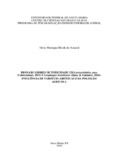| dc.creator | Amaral, Aline Monique Blank do | |
| dc.date.accessioned | 2019-10-30T15:54:15Z | |
| dc.date.available | 2019-10-30T15:54:15Z | |
| dc.date.issued | 2019-04-02 | |
| dc.identifier.uri | http://repositorio.ufsm.br/handle/1/18715 | |
| dc.description.abstract | Limnic environments are threatened worldwide, receiving loads of pollutants from various anthropogenic
activities. Brazil is one of the largest consumers of agrochemicals, especially pesticides.
These will eventually enter the aquatic systems via several mechanisms and may be
dammed, as in the reservoirs, affecting directly or indirectly their dwellers. Toxicity biomarkers
are widely used in ecotoxicology to verify deviations from the normal function. However,
biomarkers may fluctuate seasonally due to abiotic/biological factors, such as the temperature
that governs the physiology of ectothermic animals. In this study, two species of fish (Loricariichthys
anus and Geophagus brasiliensis) were collected seasonally along with abiotic variables
during one year at six sites in the Passo Real reservoir, in the Upper Jacuí basin, southern Brazil.
Eight pesticides were detected in the water. As temperature is the key factor for physiological
regulation, comparing biomarkers data from L. anus collected in the summer and in the winter,
it can be seen that in the winter there were major changes in the liver (increase of GST and
GPx) and in the gills in the summer (elevation of GST, GPx and TBARS). Increased AChE in
brain and muscle in the winter was associated with carbonylation of proteins. As the variables
act concomitantly on the organisms, a redundancy analysis was performed for both species,
considering the biochemical responses and data of pesticides, metals and abiotic factors of the
four seasons. In this way, it was evident that not only the pesticides affect the biomarkers
response, but also ammonia, nitrite, electrical conductivity and temperature. Seasonality was
clearly fundamental for both species. Although it is difficult to separate the normal fluctuations
of biomarkers from those related to the exposure of pollutants, in a long-term, these can cause
indirect effects to the populations of these species by reducing food resources or affecting fitness
by diverting energy to produce antioxidant defenses, reducing investment in other activities
such as reproduction. | eng |
| dc.description.sponsorship | Coordenação de Aperfeiçoamento de Pessoal de Nível Superior - CAPES | por |
| dc.language | por | por |
| dc.publisher | Universidade Federal de Santa Maria | por |
| dc.rights | Attribution-NonCommercial-NoDerivatives 4.0 International | * |
| dc.rights.uri | http://creativecommons.org/licenses/by-nc-nd/4.0/ | * |
| dc.subject | Sazonalidade | por |
| dc.subject | Pesticidas | por |
| dc.subject | Metais | por |
| dc.subject | Reservatório | por |
| dc.subject | Passo Real | por |
| dc.subject | Seasonality | eng |
| dc.subject | Pesticides | eng |
| dc.subject | Metals | eng |
| dc.subject | Reservoir | eng |
| dc.subject | Passo Real | eng |
| dc.title | Biomarcadores de toxicidade em Loricariichthys anus (Valenciennes, 1835) e Geophagus brasiliensis (Quoy & Gaimard, 1824): influência de variáveis abióticas e da poluição agrícola | por |
| dc.title.alternative | Toxicity biomarkers in Loricariichthys anus (Valenciennes, 1835) and Geophagus brasiliensis (Quoy & Gaimard, 1824): influence of abiotic factors and agricultural pollution | eng |
| dc.type | Tese | por |
| dc.description.resumo | Ambientes límnicos estão ameaçados mundialmente, recebendo cargas de poluentes oriundos
de diversas atividades antrópicas. O Brasil é um dos maiores consumidores de agroquímicos,
em especial pesticidas. Estes, acabarão entrando nos sistemas aquáticos via diversos mecanismos
e poderão ficar represados, especialmente nos reservatórios, afetando direta ou indiretamente
os organismos que ali vivem. Biomarcadores de toxicidade são muito utilizados em
trabalhos de ecotoxicologia para verificar desvios da função normal. Porém, biomarcadores
podem flutuar sazonalmente em razão de fatores abióticos/biológicos, como a temperatura que
governa a fisiologia de animais ecotérmicos. Neste estudo, duas espécies de peixes (Loricariichthys
anus e Geophagus brasiliensis) foram coletadas juntamente com variáveis abióticas,
sazonalmente, durante um ano em seis locais no reservatório Passo Real, bacia hidrográfica do
Alto Jacuí, região sul do Brasil. Foram detectados oito pesticidas na água. Sendo a temperatura
o fator chave para regulação fisiológica, comparando os dados dos biomarcadores de L. anus
coletados no verão e inverno pode-se perceber que no inverno houve maiores alterações no fígado
(aumento de GST e GPx) e no verão nas brânquias (elevação de GST, GPx e TBARS).
Aumento da AChE em cérebro e músculo no inverno esteve associado com a carbonilação de
proteínas. Como as variáveis atuam concomitantemente sob os organismos, foi realizada uma
análise de redundância para ambas as espécies, considerando as respostas bioquímicas e dados
de pesticidas, metais e fatores abióticos das quatro estações. Desta forma, ficou evidente
que não somente os pesticidas afetam a resposta dos biomarcadores, mas também amônia, nitrito,
condutividade elétrica e temperatura. A sazonalidade foi visivelmente fundamental para
as duas espécies. Apesar de ser difícil separar as flutuações normais dos biomarcadores daquelas
relacionadas à exposição dos poluentes, a longo prazo, esses podem causar efeitos indiretos
às populações destas espécies, ao reduzir os recursos alimentares ou afetar o fitness ao desviar
energia para produção de defesas antioxidantes, reduzindo o investimento em outras atividades
como reprodução. | por |
| dc.contributor.advisor1 | Loro, Vania Lucia | |
| dc.contributor.advisor1Lattes | http://lattes.cnpq.br/6392817606416780 | por |
| dc.contributor.referee1 | Schuch, André Passaglia | |
| dc.contributor.referee1Lattes | http://lattes.cnpq.br/4932611269622766 | por |
| dc.contributor.referee2 | Clasen, Barbara Estevao | |
| dc.contributor.referee2Lattes | http://lattes.cnpq.br/4618772929333729 | por |
| dc.contributor.referee3 | Zanette, Juliano | |
| dc.contributor.referee3Lattes | http://lattes.cnpq.br/3852213838957279 | por |
| dc.creator.Lattes | http://lattes.cnpq.br/6986347498732413 | por |
| dc.publisher.country | Brasil | por |
| dc.publisher.department | Bioquímica | por |
| dc.publisher.initials | UFSM | por |
| dc.publisher.program | Programa de Pós-Graduação em Biodiversidade Animal | por |
| dc.subject.cnpq | CNPQ::CIENCIAS BIOLOGICAS::BIOQUIMICA | por |
| dc.publisher.unidade | Centro de Ciências Naturais e Exatas | por |



